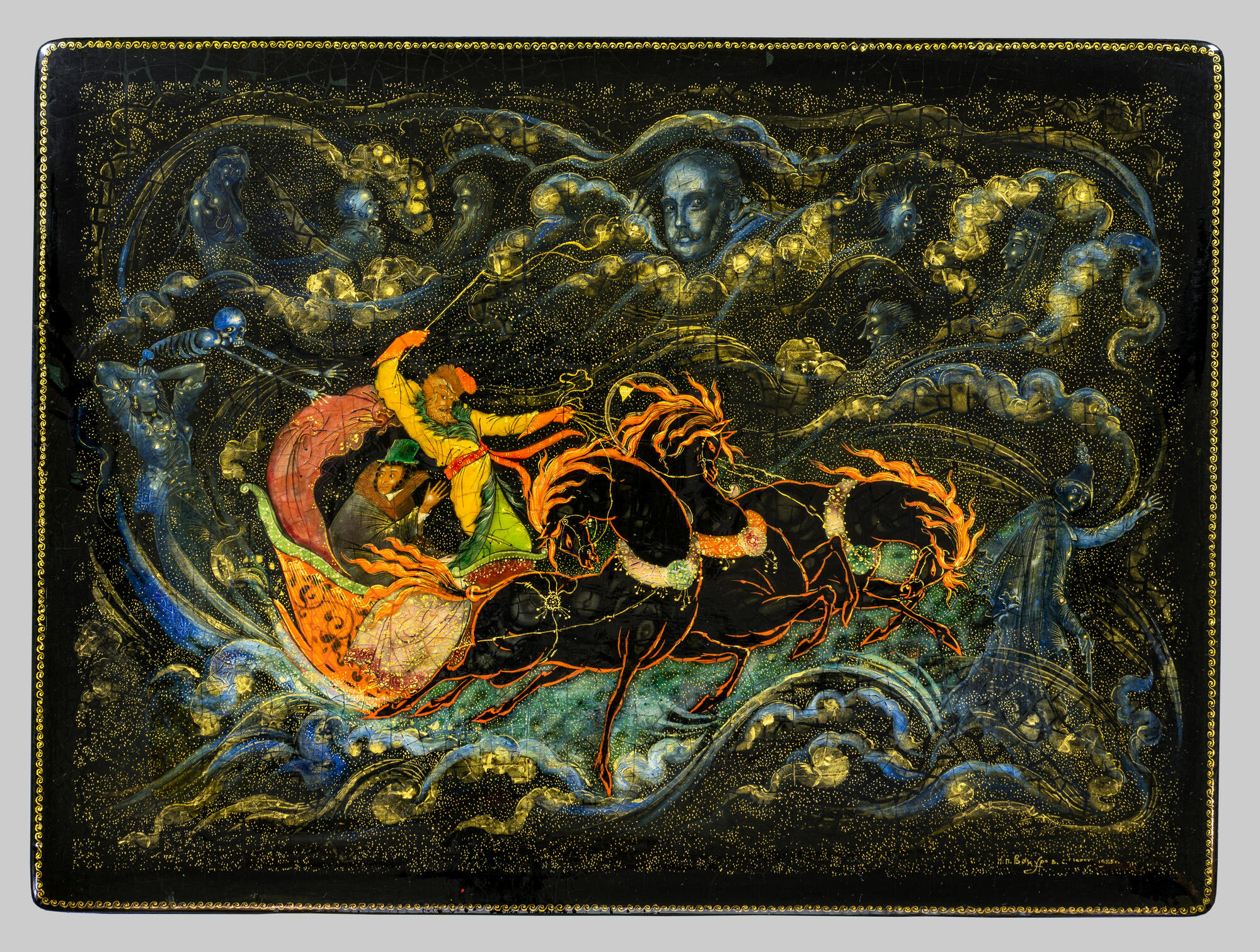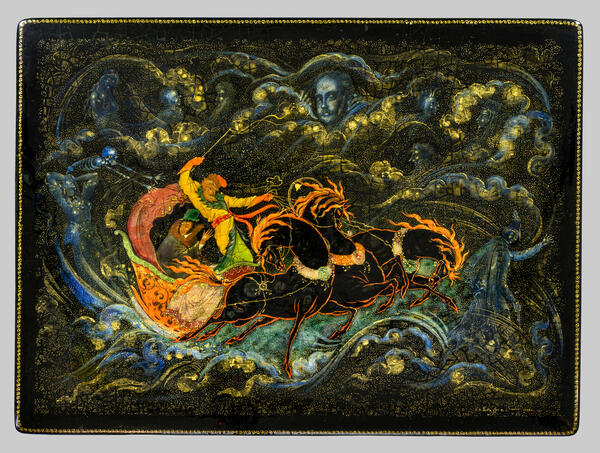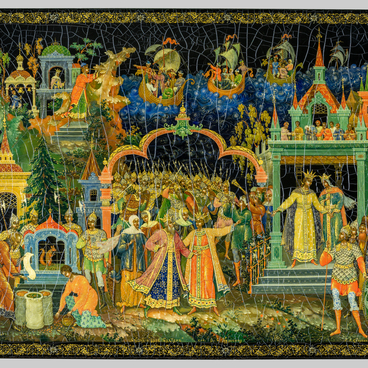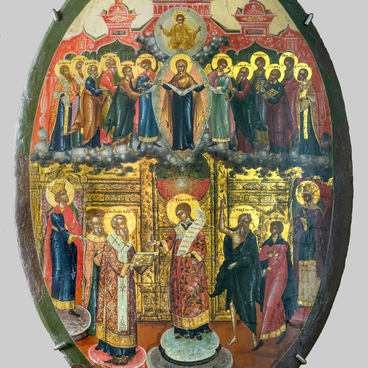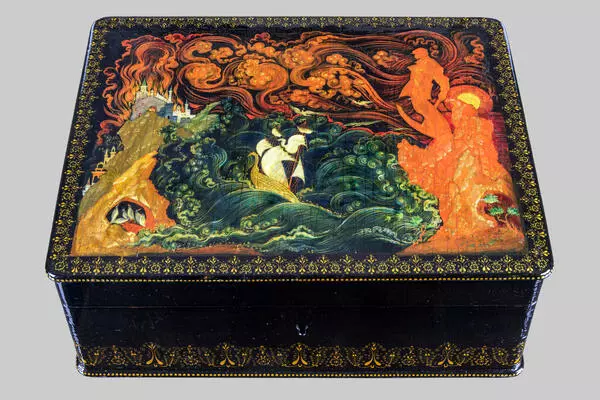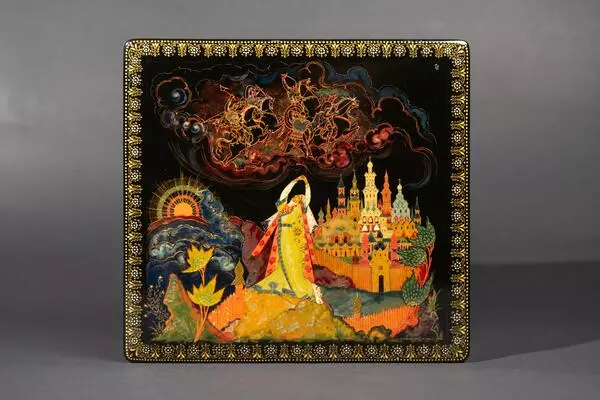The casket with the composition ‘The Demons’ was created by the People’s Artist of the Russian Soviet Federative Socialist Republic Ivan Vakurov in 1935. He was inspired by the poem of the same name by Alexander Pushkin, which begins with the words, “Clouds are whirling, clouds are swirling; though invisible, the moon lights the flying snow while blurring turbid sky and nigh in one.” Reading Pushkin’s lines, Ivan Vakurov imagined pitch-black darkness and a lonely traveler making his way through a storm in fear.
‘The Demons’ are not just an illustration for a poem. Here, the Palekh artist reflects on the tragic fate of Pushkin himself. Ivan Vakurov painted the frightened poet rushing through a blizzard in a carriage. Pushkin’s likeness is very accurate and easily recognisable.
Various images emerge from the raging storm: the shadow of d’Anthès with a pistol, the bony death with outstretched hands, Pushkin’s crying wife, and the faces of the courtiers and Nicholas the First. The artist depicted them as barely noticeable silhouettes on a black background. Ivan Vakurov showed not just a storm in the darkness of the night but created an image of life hostile to the poet.
The fierce storm does not frighten only the mighty coachman, who symbolizes the fearless Russian people. “The Demons” are one of the author’s interpretations of the Russian ‘troika’ (three horses) motive popular with the Palekh painters.
The black background was one of the most important elements of Vakurov’s dramatic works. The artist applied large spots of local colors like blue, green, orange, and bright vermilion over the background. In the past, the vivid red vermilion pigment was produced from cinnabar, a mercury-yielding mineral. The artist left large pieces of the background untouched, connecting them with the intense color spots. This miniature shows the best Vakurov’s works have to offer: a simple and elegant composition, sharp curves, and expressive colors.
Ivan Vakurov was born in 1885 and died in 1968. He was an icon painter during the tsarist rule. Then, when the attitude towards religion changed during the Soviet period, he became the founder of the Palekh lacquer miniature tradition. His best works can be found at the State Museum of Palekh Art. Researchers call Ivan Vakurov an artist and philosopher: he tried to show the audience his vision of the world through his artistic images. ‘The Demons’ miniature is seen not as illustrative art, but rather as the author’s reflection on the tragic fate of a genius.
‘The Demons’ are not just an illustration for a poem. Here, the Palekh artist reflects on the tragic fate of Pushkin himself. Ivan Vakurov painted the frightened poet rushing through a blizzard in a carriage. Pushkin’s likeness is very accurate and easily recognisable.
Various images emerge from the raging storm: the shadow of d’Anthès with a pistol, the bony death with outstretched hands, Pushkin’s crying wife, and the faces of the courtiers and Nicholas the First. The artist depicted them as barely noticeable silhouettes on a black background. Ivan Vakurov showed not just a storm in the darkness of the night but created an image of life hostile to the poet.
The fierce storm does not frighten only the mighty coachman, who symbolizes the fearless Russian people. “The Demons” are one of the author’s interpretations of the Russian ‘troika’ (three horses) motive popular with the Palekh painters.
The black background was one of the most important elements of Vakurov’s dramatic works. The artist applied large spots of local colors like blue, green, orange, and bright vermilion over the background. In the past, the vivid red vermilion pigment was produced from cinnabar, a mercury-yielding mineral. The artist left large pieces of the background untouched, connecting them with the intense color spots. This miniature shows the best Vakurov’s works have to offer: a simple and elegant composition, sharp curves, and expressive colors.
Ivan Vakurov was born in 1885 and died in 1968. He was an icon painter during the tsarist rule. Then, when the attitude towards religion changed during the Soviet period, he became the founder of the Palekh lacquer miniature tradition. His best works can be found at the State Museum of Palekh Art. Researchers call Ivan Vakurov an artist and philosopher: he tried to show the audience his vision of the world through his artistic images. ‘The Demons’ miniature is seen not as illustrative art, but rather as the author’s reflection on the tragic fate of a genius.
